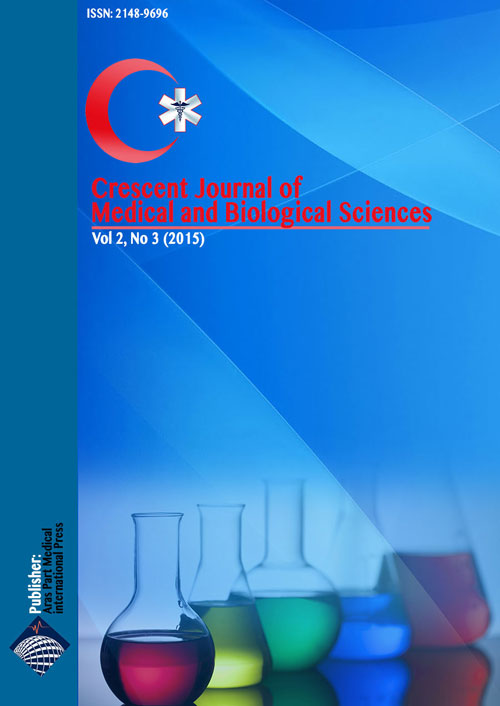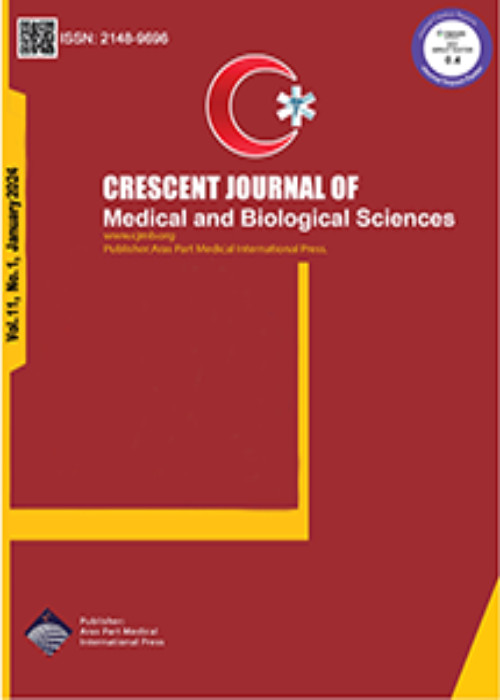فهرست مطالب

Crescent Journal of Medical and Biological Sciences
Volume:2 Issue: 3, Jul 2015
- تاریخ انتشار: 1394/06/11
- تعداد عناوین: 8
-
-
Pages 71-75ObjectiveDue to critical clinical situation and use of mechanical devices, managements including antibiotics and contact with hospital environment and healthcare workers, patients in intensive care units (ICUs) are susceptible to various infections, particularly those arising from aerobic gram-negative bacilli with multi-drug resistance. Knowledge of the pattern of antibiotics susceptibility and their empirical therapy helps prevent and reduce morbidity and mortality of infectious disease in ICU.Materials And MethodsIn this retrospective study, the medical records of all patients admitted to ICUs of Sina hospital of Tabriz from 2011 to 2015 were evaluated, and the information was extracted from questionnaires and statistically analyzed with SPSS 16.ResultsAmong a total of 332 patients, 101 (30.42%) had nosocomial infection with gram-negative bacilli and Escherichia coli (E. coli) had the highest prevalence (35.6%). Urinary tract infection (UTI) (76.23%), pneumonia (18.81%), and septicemia (4.9%) were the most frequent nosocomial infections. Forty-one patients (12.3%) had positive cultures for gram-positive and fungal infections. Additionally, 46.53% of patients were female, and no significant difference existed between the gender quality variable and the isolated aerobic gram-negative bacilli (P >. 005). The highest antibiotic resistance was against ampicillin, amikacin and piperacillin and the highest sensitivity was to imipenem.ConclusionUrinary tract and respiratory tract infections were the first and second common source of infection in ICU and E. coli as an aerobic gram-negative bacillus was the most important etiologic agent. The highest antibiotic susceptibility was to imipenem.Keywords: Gram, negative aerobic bacteria, Drug resistance, Intensive care units
-
Pages 76-80ObjectiveCinnamaldehyde is the main active component of cinnamon essential oil with antibacterial and antifungal effects. This in vitro study was done to investigate the effect of cinnamaldehyde on the growth of standard strain of Candida albicans (C. albicans) in comparison to nystatin suspension and fluconazole.Materials And MethodsThe tests were designed for the three groups of this study namely cinnamaldehyde, fluconazole and nystatin. Standard strain of C. albicans (PTCC 5027) was used. Three methods namely disc diffusion, well diffusion and microdilution were used. Based on elevation of cinnamaldehyde concentrations, its antifungal effect was increased.ResultsThe minimum inhibitory concentration (MIC) of antifungal effect of cinnamaldehyde was 0.312 μl/ml. This effect is similar to the effect of 100000 IU/ml nystatin in concentration of 20 μl/ml and 1% fluconazole in concentration of 40 μl/ml. The mean (±SD) of inhibition zone diameter in concentration of 80 μl/ml for disc and well diffusion were 60.4 (±2.2) and 70 (±3.5) mm, respectively.ConclusionThese inhibition zones were larger than the zones for fluconazole and nystatin groups. According to the results, cinnamaldehyde has dose-dependent anti-C. albicans effect. In some concentrations, the cinnamaldehyde effect is similar to fluconazole and nystatin.Keywords: Candida albicans, Cinnamaldehyde, Cinnamon, DMSO
-
Pages 81-86ObjectiveIn recent decades, in low-income developing countries, management has faced serious challenges due to deficient information. An increasing number of dispersed data, concepts, observation of poor outputs, and separate software applications aggravated the situation, too. In order to promote and balance the research environment in the field of health, developing a platform for appropriate interactions is essential. Thus, the basic question is what requirements must be considered for suitable health research information system in Iran?Materials And MethodsThe present study is a descriptive-comparative approach conducted in Iran in the years 2010-2011. System requirements of research information in Iran, United States, Australia, Japan and Netherland were reviewed and compared. Checklist was used for data collection. Data was collected from conference and journals papers and relevant manuals/guidelines from websites on their systems. Finally, data collected in the comparative tables were compared and described.ResultsThe requirement for national health research information system were determined based on the following central axis: structure, content, methods of gathering information, services and capabilities and methods of disseminating information which were assigned base on common and diverse components in countries’ systems.ConclusionIn order to achieve this national system, it is important that there should be a common serious determination for its development, change in attitude and culture of the researcher’s society in the domain of health and also improvement in the country’s information and communications technology (ICT) infrastructure.Keywords: Health, Information system, Iran, Management information research, Research information, Research information system
-
Pages 87-89ObjectiveCardiovascular disease (CVD) is one of the fatal complications of diabetes mellitus. The mortality of CVD is higher in diabetic persons. Women are at a higher risk for CVD. The purpose of this study is to determine the perception of CVD risk among women with type 2 diabetes mellitus.Materials And MethodsThis cross-sectional study was conducted among 58 diabetic women with type 2 diabetes in a Diabetes clinic in Qaen, South Khorasan province, Iran. The attitude of participants towards CVD was assessed by a modified RPS-DD questionnaire. Data were analyzed with SPSS version 20.ResultsThe participants aged from 31 to 66 years old. The mean duration of diabetic diagnosis was 7±4.88 years. Majority of them were literate (56.9%), married (89.7%), had low income (52%) and were housekeepers (94.8%). Almost half the participants believed they had personal control over cardiovascular risk. 69% had optimistic attitude towards not getting CVD and 60.3% had a moderate level of concerns about cardiovascular risks. Also 80% had knowledge about the cardiovascular risks.ConclusionRisk perception plays an important role in preventing CVD. A comprehensive educational program for changing the attitude toward CVD is recommended.Keywords: Cardiovascular diseases, Diabetes mellitus, Health, Perception, Women
-
Pages 90-94ObjectiveDue to existing association between high-density lipoprotein (HDL) and cardiovascular disease, detection of factors affecting this lipid is important. Environmental factors and genetic variations have an important role in HDL level. The effects of these risk factors can be time-dependent; so, study of their effects on HDL level over time is important. In this study, we used transition model to analyze binary longitudinal data to investigate single nucleotide polymorphism (SNP) and other risk factors affecting low HDL over time.Materials And MethodsData of 329 participants of 3 phases of Tehran Lipid and Glucose Study (TLGS) was analyzed using marginal transition model. This model has a formulation which allows first and second order Markov dependence to take into account the correlation among successive observations of the same individual in longitudinal binary response for which the marginal probability of success is modelled via a form of logistic regression.ResultsResults of first order transition model showed that the odds ratio (OR) for having low HDL in women compared to men was 1.54 (95% CI: 1.02, 2.24). High waist circumference (OR = 1.67, CI 95%: 1.16, 2.39), high blood pressure (OR = 0.59, 95% CI: 0.41, 0.85), high triglyceride (OR = 1.85, 95% CI: 1.30, 2.65) and being homozygous for the minor allele of SRB1 (OR = 0.11, 95% CI: 0.01, 0.74) were significantly associated with low HDL. Also, the OR of low HDL in phase 2 of study compared to phase 1 was 1.76 (95% CI: 1.32, 2.35). The result of second order transition model was fairly similar to first order. The parameter estimates of serial dependency are markedly significant, pointing clearly to a first and second-order serial dependence (P <. 001).ConclusionConsidering the identification of genetic and environmental factors affecting low HDL over time, transition model was used and the most important risk factors were identified.Keywords: Low HDL, Markov chains, Transition regression
-
Pages 95-99ObjectiveNigella sativa Linn., which grows wildly in a small region of the national park of Golestan has been used in traditional medicine of this province. In the present study we evaluated the ecological requirements, antioxidant activity, phytochemistry and conducted an ethno-pharmacological survey of Nigella sativa in traditional medicine of Golestan province.Materials And MethodsEcological requirements and ethno-pharmacological survey were obtained in many field observation through interviews with practitioners and housewives in September 2013. The ripen seeds of Nigella sativa were collected from its natural habitat (560 m) in North east of national park of Golestan and ethanolic extract was obtained by maceration. Total phenolics (TPs) and total flavonoids (TFs) contents were determined spectrophotometrically and antioxidant activity was measured by 1,1-diphenyl-2-picryl hydrazyl (DPPH) radical scavenging method.ResultsNigella sativa is usually grown wildly in a small region of the national park of Golestan (500-760 m), that has an average rain fall of 575.9-614.8 mm, Ec (electrical conductivity of soil) 0.73 in sandy loam soils. The TP content is 121.3 ± 0.3 mg GAE g-1, TF contents was 194.04 ± 1.65 mg QUE g-1 and antioxidant activity (IC50) was measured in 0.13 ± 0.05 mg/ml-1. Results showed that the seeds of Nigella sativa has high content of TP and TF compounds as well as antioxidant activity, confirming the traditional use of Nigella sativa by rural healers as analgesic, anti-inflammatory, antiseptic, anticonvulsant, antidiabetes and antitumour agent against breast cancer, hypertension and hyperglycaemia in north of Iran.ConclusionOur results demonstrated that the seed extract of Nigella sativa L. could have good antioxidant potentials to prevent or control free radicals, which can produce many current inflammatory diseases such as cancer, diabetes, coronary diseases, infection, etc. So these data confirm the traditional use of this plant with its terpenoides, flavonoid and phenolic compounds.Keywords: Antioxidants, Ethnopharmacology, Nigella sativa Linn., Phytochemical
-
Pages 100-101IntroductionAlthough aberrant right subclavian artery (ARSA) is a rare abnormality but it is the most common anomaly of aortic arch. Compressive effects of the artery are responsible for the patients’ symptoms. Association of this disorder with other anomalies and necessity of treatment in symptomatic patients are the important aspects of this condition.Case PresentationHere we describe a 12 years old girl with dysphagia and ultimate diagnosis of ARSA. The ligation procedure of the artery was successful without any complications.ConclusionDysphagia could be the main symptom of the ARSA in children as same as old adults.Keywords: Aberrant subclavian artery, Aortic arch anomaly, Dysphagia
-
Pages 102-103


